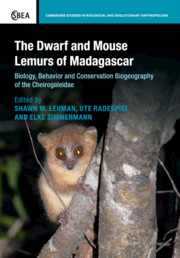 The Dwarf and Mouse Lemurs of Madagascar
The Dwarf and Mouse Lemurs of Madagascar from Part II - Methods for studying captive and wild cheirogaleids
Published online by Cambridge University Press: 05 March 2016
Introduction
Ectoparasites of terrestrial mammals include several groups of insects (lice, fleas, louse flies, and others) and arachnids (mites and ticks) that inhabit the host skin or pelage and have morphological adaptations for this habitat and for host attachment. A diverse assemblage of blood-feeding flies including mosquitoes, sandflies, black flies, biting midges, horse and deer flies and certain muscoid flies have very short-term associations with mammals (only during feeding) and do not have adaptations for living on hosts; these flies will not be discussed in detail in this chapter. Ectoparasites are a diverse component of the Malagasy fauna, and have the potential to impact the health and well-being of their hosts. Because lemurs provide a biotic environment and ecosystem for their ectoparasites, an understanding of lemur ecology can directly include lemur ectoparasite ecology; similarly, an understanding of lemur ectoparasites can provide further information on the health and evolutionary history of their hosts. Unfortunately, there has been no coordinated research effort to investigate these parasites, and most of the research has been directed only at the description of new taxa. Consequently, very little is known about the relationships between cheirogaleid lemurs and their ectoparasites; however, there is great potential for the ecological and systematic relationships between these parasites and their hosts to be revealed.
Ectoparasites include lice (Phthiraptera), fleas (Siphonaptera), louse flies (Diptera), true bugs (Hemiptera), and ticks and mites (Arachnida: Acari). Most mites known to biologists are free-living, predaceous or plant-feeders, but there is a very diverse subgroup that includes parasites of animals. In contrast, all ticks are parasites, feeding primarily on the blood of their hosts and acting as vectors for numerous infectious pathogens. Sucking lice are dorsoventrally flattened, feed exclusively on the blood of their hosts and also spend every stage (eggs, three nymphal instars and adults) of their life cycle on the host. Members of the Siphonaptera (fleas) are bilaterally flattened, wingless insects that feed solely on the blood of birds and mammals. A few members of the Hemiptera (true bugs) are important blood-feeders and, in the neotropical region, some are vectors of a zoonotic protozoan parasite.
To save this book to your Kindle, first ensure [email protected] is added to your Approved Personal Document E-mail List under your Personal Document Settings on the Manage Your Content and Devices page of your Amazon account. Then enter the ‘name’ part of your Kindle email address below. Find out more about saving to your Kindle.
Note you can select to save to either the @free.kindle.com or @kindle.com variations. ‘@free.kindle.com’ emails are free but can only be saved to your device when it is connected to wi-fi. ‘@kindle.com’ emails can be delivered even when you are not connected to wi-fi, but note that service fees apply.
Find out more about the Kindle Personal Document Service.
To save content items to your account, please confirm that you agree to abide by our usage policies. If this is the first time you use this feature, you will be asked to authorise Cambridge Core to connect with your account. Find out more about saving content to Dropbox.
To save content items to your account, please confirm that you agree to abide by our usage policies. If this is the first time you use this feature, you will be asked to authorise Cambridge Core to connect with your account. Find out more about saving content to Google Drive.